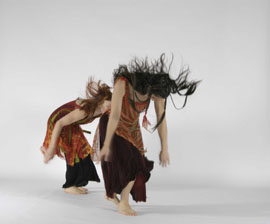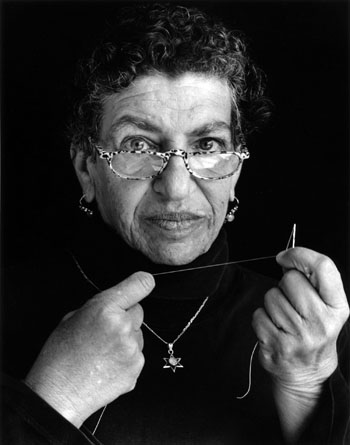Why do you make art? That’s the simple question Greater Good posed to seven artists. Their answers are surprising and very diverse. They mention making art for fun and adventure; building bridges between themselves and the rest of humanity; reuniting and recording fragments of thought, feeling, and memory; and saying things that they can’t express in any other way.
All their answers are deeply personal. In this issue of Greater Good, we explore the possible cognitive and emotional benefits of the arts, and yet these artists evoke a more fundamental benefit: they are just doing what they feel they’re born to do.
1. Gina Gibney: Giving power to others
Gina Gibney is the artistic director of the New York-based Gina Gibney Dance Company, which was founded in 1991 to serve a dual mission: to create and perform contemporary choreography that draws upon the strength and insights of women and men, and to enrich and reshape lives through programs that give voice to communities in need, especially survivors of domestic abuse and individuals living with HIV/AIDS.
“I make art for a few reasons. In life, we experience so much fragmentation of thought and feeling. For me, creating art brings things back together. In my own work, that is true throughout the process. In the beginning, developing the basic raw materials for the work is deeply reflective and informative. Later, bringing those materials together into a form — distilling and shaping movement, creating a context, working toward something that feels cohesive and complete. That’s incredibly powerful for me — something that really keeps me going.

© Andrzej Olejniczak/Gina Gibney
“I make art for a few reasons. In life, we experience so much fragmentation of thought and feeling. For me, creating art brings things back together.”
“Dance is a powerful art form for the very reason that it doesn’t need to explain or comment on itself. One of the most amazing performances I have ever seen in my life was of a woman — a domestic violence survivor — dancing in a tiny conference room in a domestic violence shelter for other survivors. She was not a professional dancer. She was a woman who had faced unbelievable challenges and who was living with a great deal of sadness. She created and performed an amazing solo — but to have described her performance as “sad” would have been to diminish what we experienced.
“That’s the power of dance. You can feel something and empathize with it on a very deep level, and you don’t have to put words to it.”
2. Judy Dater: I like expressing emotions
Judy Dater has been making photographs for more than 40 years and is considered one of America’s foremost photographers. The recipient of a Guggenheim and many other awards, her books include Imogen Cunningham: A Portrait, Women and Other Visions, Body and Soul and Cycles.
“I like expressing emotions — to have others feel what it is I’m feeling when I’m photographing people.
“Empathy is essential to portraiture. I’ve done landscapes, and I think they can be very poetic and emotional, but it’s different from the directness of photographing a person. I think photographing people is, for me, the best way to show somebody something about themselves — either the person I photograph or the person looking — that maybe they didn’t already know. Maybe it’s presumptuous, but that’s the desire. I feel like I’m attending to people when I’m photographing them, and I think I understand people better because I’ve been looking at them intensely for 40-some years.”

A portrait by Judy Dater
3. Pete Docter: It’s fun making things
Pete Docter has been involved in some of Pixar Studio’s most popular and seminal animated features, including Toy Story, A Bug’s Life, Cars, and Wall-E, but he is best known as the director of the Academy-Award-winning Monsters, Inc. Docter is currently directing Up, set for release in May of 2009.
“I make art primarily because I enjoy the process. It’s fun making things. And I’m sure there is also that universal desire to connect with other people in some way, to tell them about myself or my experiences.
RELATED: The Life Cube – changing the world through art
“What I really look for in a project is something that resonates with life as I see it, and speaks to our experiences as humans. That probably sounds pretty highfalutin’ coming from someone who makes cartoons, but I think all the directors at Pixar feel the same way. We want to entertain people, not only in the vacuous, escapist sense (though to be sure, there’s a lot of that in our movies too), but in a way that resonates with the audience as being truthful about life — some deeper emotional experience that they recognize in their own existence.
“I make art primarily because I enjoy the process. It’s fun making things. And I’m sure there is also that universal desire to connect with other people in some way.”
“On the surface, our films are about toys, monsters, fish or robots; at a foundational level, they’re about very universal things: our own struggles with mortality, loss and defining who we are in the world. As filmmakers, we’re pretty much cavemen sitting around the campfire telling stories, only we use millions of dollars of technology to do it. By telling stories, we connect with each other. We talk about ourselves, our feelings, and what it is to be human. Or we just make cartoons. Either way, we try to have a good time, and we hope the audience does too.”
4. Harrell Fletcher: Anything anyone calls art is art
Harrell Fletcher teaches in the art department at Portland State University. He has exhibited at the San Francisco Museum of Modern Art, the Berkeley Art Museum, Socrates Sculpture Park in New York, and in numerous other museums and galleries around the world. In 2002, Fletcher started Learning To Love You More, a participatory website with Miranda July, which they turned into a book, published in 2007. Fletcher is the recipient of the 2005 Alpert Award in Visual Arts.
“The question of why I make art needs to be broken down a bit before I can answer. First of all, what is art? The definition of art that I have come up with, which seems to work best for me, is that anything anyone calls art is art. This comes from my belief that there is nothing intrinsic about art. We cannot do a chemical analysis to determine if something is art or not. Instead, I feel like calling something “art” is really just a subjective way of indicating value — which could be aesthetic, cultural, monetary and so on.
© Harell Fletcher. An image from "The Problem of Possible Redemption 2003"
“If we look at other kinds of creative activity we can see how various forms can all exist and be valid at the same time. I’ve made what I think of as art since I was a child, initially drawings, then photographs, paintings, videos, and so on. By the time I got to graduate school, I was not so interested in making more stuff, and instead started to move into another direction, which these days is sometimes called “Social Practice.”
“This is sort of a confusing term since it is so new and undefined. In a broad way, I think of it as the opposite of Studio Practice — making objects in isolation, to be shown and hopefully sold in a gallery context. Most of the art world operates with this Studio Practice approach. In Social Practice, there is more of an emphasis on ideas and actions than on objects; it can take place outside of art contexts, and there is often a collaborative or participatory aspect to the work.
“So, back to the question why I make art. In my case, the projects that I do allow me to meet people I wouldn’t ordinarily meet, travel to places I wouldn’t normally go to, learn about subjects that I didn’t know I would be interested in, and sometimes even help people out in small ways that make me feel good. I like to say that what I’m after is to have an interesting life and doing the work that I do as an artist helps me achieve that.
5. Kwame Dawes: An environment of empathy
Kwame Dawes, Ph.D., is Distinguished Poet in Residence at the University of South Carolina. He is the author of 13 books of verse, most recently Gomer’s Song, and a novel, She’s Gone, which won the 2008 Hurston/Wright Legacy Award for Best First Novel.
“I write in what is probably a vain effort to somehow control the world in which I live, recreating it in a manner that satisfies my sense of what the world should look like and be like. I’m trying to capture in language the things that I see and feel, as a way of recording their beauty and power and terror, so that I can return to those things and relive them. In that way, I try to have some sense of control in a chaotic world.

© Rachel Eliza Griffiths
“I want to somehow communicate my sense of the world — that way of understanding, engaging, experiencing the world — to somebody else. I want them to be transported into the world that I have created with language.
“And so the ultimate aim of my writing is to create an environment of empathy, something that would allow the miracle of empathy to take place, where human beings can seem to rise out of themselves and extend themselves into others and live within others. That has a tremendous power for the human being. And I know this because that is what other people’s writing does to me when I read it.”
6. James Sturm: The reasons are unimportant
James Sturm is a cartoonist and co-founder of the Center for Cartoon Studies in White River Junction, Vermont. He is the author of the best-selling and award-winning graphic novel The Golem’s Mighty Swing, chosen as the Best Graphic Novel of 2000 by Time magazine. In 2007, his trilogy of historical graphic novels was collected in a volume entitled James Sturm’s America: God, Gold, and Golems.
“I like the question “Why do you make art?” because it assumes what I do is art. A flattering assumption. The question also takes me back to my freshman year of college, where such questions like “What is nature?” and “Is reality a wave or a circle?” were earnestly debated (usually late at night and after smoking too much weed).
“Twenty-five years later I’d like to think I am a little more clear-headed regarding this question. Perhaps the only insight I’ve gained is the knowledge that I have no idea and, secondly, the reasons are unimportant. Depending on my mood, on any given day, I could attribute making art to a high-minded impulse to connect with others or to understand the world or a narcissistic coping mechanism or a desire to be famous or therapy or as my religious discipline or to provide a sense of control or a desire to surrender control, etc., etc., etc.
“Whatever the reason, an inner compulsion exists and I continue to honour this internal imperative. If I didn’t, I would feel really horrible. I would be a broken man. So, whether attempting to make art is noble or selfish, the fact remains that I will do it nevertheless. Anything past this statement is speculation. I would be afraid that by proclaiming why I make art would be generating my own propaganda.”
7. KRS-One: Hip-hop is beyond time, beyond space
Lawrence Krisna Parker, better known by his stage name KRS-One, is widely considered by critics and other MCs to be one of hip-hop’s most influential figures. At the 2008 Black Entertainment Television Awards, KRS-One was the recipient of the Lifetime Achievement Award for his rapping and activism.
“I was born this way, born to make art, to make hip-hop. And I think I’m just one of the people who had the courage to stay with my born identity. Hip-hop keeps me true to myself, keeps me, human.
“Hip-hop is the opposite of technology. Hip-hop is what the human body does: Breaking, DJing, graffiti writing. The human body breakdances, you can’t take that away. DJing is not technology; it’s human intelligence over technology: cutting, mixing, scratching. It’s physical. The manipulation of technology is what humans do, that’s art.
“I was born this way, born to make art, to make hip-hop. And I think I’m just one of the people who had the courage to stay with my born identity.”
“Or take graffiti writing. Put a writing utensil in any kid’s hand at age two or three. They will not write on a paper like they’ll later be socialized to do, they will write on the walls. They’re just playing. That’s human. Graffiti reminds you of your humanity when you scrawl your self-expression on the wall. Hip-hop helps us to see the things in the world in new ways.
“That’s why hip hop has kept me young. It doesn’t allow you to grow up too fast. Hip hop is beyond time, beyond space. That’s why I make hip-hop.” ●






Join the conversation
You are posting as a guest. If you have an account, sign in now to post with your account.
There are no comments to display.